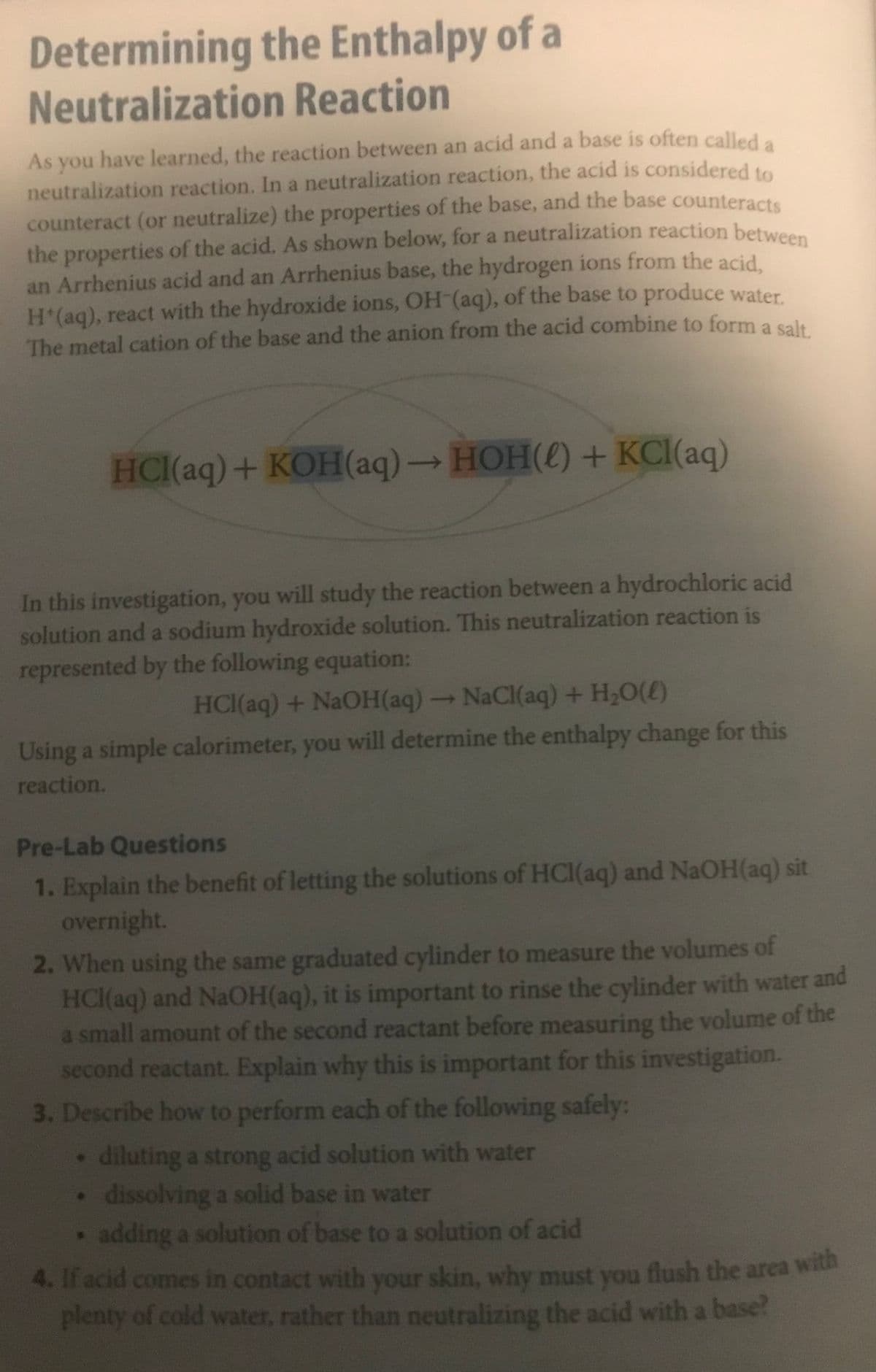1. Explain the benefit of letting the solutions of HCl(aq) and NaOH(aq) sit overnight. 2. When using the same graduated cylinder to measure the volumes of HCl(aq) and NaOH(aq), it is important to rinse the cylinder with water and a small amount of the second reactant before measuring the volume of the second reactant. Explain why this is important for this investigation. 3. Describe how to perform each of the following safely: diluting a strong acid solution with water dissolving a solid base in water adding a solution of base to a solution of acid
1. Explain the benefit of letting the solutions of HCl(aq) and NaOH(aq) sit overnight. 2. When using the same graduated cylinder to measure the volumes of HCl(aq) and NaOH(aq), it is important to rinse the cylinder with water and a small amount of the second reactant before measuring the volume of the second reactant. Explain why this is important for this investigation. 3. Describe how to perform each of the following safely: diluting a strong acid solution with water dissolving a solid base in water adding a solution of base to a solution of acid
Chemistry: An Atoms First Approach
2nd Edition
ISBN:9781305079243
Author:Steven S. Zumdahl, Susan A. Zumdahl
Publisher:Steven S. Zumdahl, Susan A. Zumdahl
Chapter7: Chemical Energy
Section: Chapter Questions
Problem 134IP: On Easter Sunday, April 3, 1983, nitric acid spilled from a tank car near downtown Denver, Colorado....
Related questions
Question
Please help me answer the 4 pre lab questions (Determining the ethalpy of neutralization reactions)

Transcribed Image Text:Determining the Enthalpy of a
Neutralization
Reaction
As you have learned, the reaction between an acid and a base is often called a
neutralization reaction. In a neutralization reaction, the acid is considered to
counteract (or neutralize) the properties of the base, and the base counteracts
the properties of the acid. As shown below, for a neutralization reaction between
an Arrhenius acid and an Arrhenius base, the hydrogen ions from the acid,
H*(aq), react with the hydroxide ions, OH (aq), of the base to produce water.
The metal cation of the base and the anion from the acid combine to form a salt.
HCl(aq) + KOH(aq) → HOH() + KCl(aq)
In this investigation, you will study the reaction between a hydrochloric acid
solution and a sodium hydroxide solution. This neutralization reaction is
represented by the following equation:
HCl(aq) + NaOH(aq) → NaCl(aq) + H₂O(l)
Using a simple calorimeter, you will determine the enthalpy change for this
reaction.
Pre-Lab Questions
1. Explain the benefit of letting the solutions of HCl(aq) and NaOH(aq) sit
overnight.
2. When using the same graduated cylinder to measure the volumes of
HCl(aq) and NaOH(aq), it is important to rinse the cylinder with water and
a small amount of the second reactant before measuring the volume of the
second reactant. Explain why this is important for this investigation.
3. Describe how to perform each of the following safely:
• diluting a strong acid solution with water
• dissolving a solid base in water
• adding a solution of base to a solution of acid
4. If acid comes in contact with your skin, why must you flush the area with
plenty of cold water, rather than neutralizing the acid with a base?
Expert Solution
This question has been solved!
Explore an expertly crafted, step-by-step solution for a thorough understanding of key concepts.
Step by step
Solved in 5 steps

Knowledge Booster
Learn more about
Need a deep-dive on the concept behind this application? Look no further. Learn more about this topic, chemistry and related others by exploring similar questions and additional content below.Recommended textbooks for you

Chemistry: An Atoms First Approach
Chemistry
ISBN:
9781305079243
Author:
Steven S. Zumdahl, Susan A. Zumdahl
Publisher:
Cengage Learning

Chemistry
Chemistry
ISBN:
9781305957404
Author:
Steven S. Zumdahl, Susan A. Zumdahl, Donald J. DeCoste
Publisher:
Cengage Learning


Chemistry: An Atoms First Approach
Chemistry
ISBN:
9781305079243
Author:
Steven S. Zumdahl, Susan A. Zumdahl
Publisher:
Cengage Learning

Chemistry
Chemistry
ISBN:
9781305957404
Author:
Steven S. Zumdahl, Susan A. Zumdahl, Donald J. DeCoste
Publisher:
Cengage Learning


Introductory Chemistry: An Active Learning Approa…
Chemistry
ISBN:
9781305079250
Author:
Mark S. Cracolice, Ed Peters
Publisher:
Cengage Learning

General Chemistry - Standalone book (MindTap Cour…
Chemistry
ISBN:
9781305580343
Author:
Steven D. Gammon, Ebbing, Darrell Ebbing, Steven D., Darrell; Gammon, Darrell Ebbing; Steven D. Gammon, Darrell D.; Gammon, Ebbing; Steven D. Gammon; Darrell
Publisher:
Cengage Learning

Chemistry & Chemical Reactivity
Chemistry
ISBN:
9781133949640
Author:
John C. Kotz, Paul M. Treichel, John Townsend, David Treichel
Publisher:
Cengage Learning